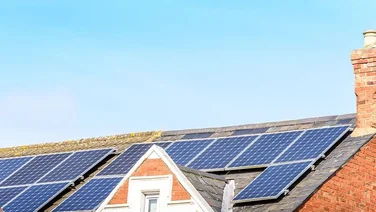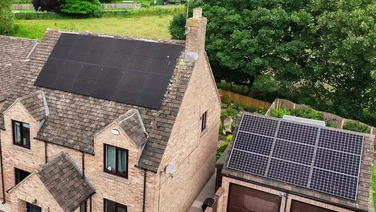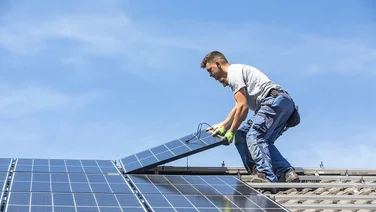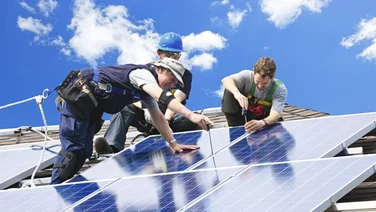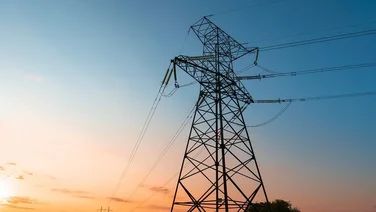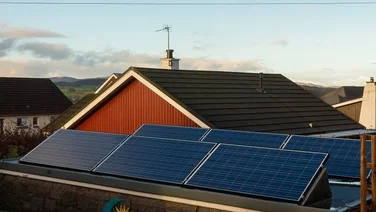- Do solar panels work in a heatwave?
- How hot can it get before solar panels stop working?
- Are there any electrical dangers when solar panels overheat?
- What’s the ideal temperature for a solar panel?
- When’s the best time of year for solar panels?
- How to keep solar panels cool in hot weather
- Can hot weather affect any other energy sources?
- Next steps
✔ Modern solar panels work just fine up to 85°C
✔ Solar panels produce slightly less power over 25°C
✔ Even at 85°C, solar panels typically generate 81% of their peak output
Thinking of investing in solar? Before you start, you’ll want to know how solar panels work and how well they’ll work in your home, which means learning their strengths and weaknesses.
In this guide, we’ll tackle one of the most pervasive myths about solar panels: that they can stop working when it gets a bit hot.
We’ll explain the high temperatures solar panels can withstand, what the ideal level of warmth is for your panels, and which months of the year will see them produce the most solar energy.
If you’re ready to compare solar panel prices, do it with our help. Just provide a few quick details, and our expert installers will be in touch with free quotes for you to compare.
Where do you want to install solar panels?
Get started
Do solar panels work in a heatwave?
350 W solar panel | 30°C | 35°C | 40°C | Light cloud | Heavy cloud |
|---|---|---|---|---|---|
Wh generated | 344 | 339 | 333 | 266 | 116 |
% of maximum power | 98 | 97 | 95 | 76 | 33 |
Solar panels work very well in a heatwave.
They generate much more electricity when it’s hot than on cloudy days, assuming the heatwave comes with relatively clear skies.
Solar panels do, unfortunately, lose a small fraction of their efficiency with every degree that their temperature – not the air temperature – creeps over 25°C.
However, this loss is negligible when compared with days when the sun isn’t shining directly on your panels.
Even at its maximum operating temperature of 85°C, a typical solar panel’s power output is still better than it is on a day with light cloud cover.
What is a solar panel’s ‘temperature coefficient’?
A solar panel’s temperature coefficient refers to the amount of power output lost when its temperature is higher than 25°C.
You’ll usually see it referred to as something like ‘temperature coefficient (Pmax)’ on solar panel datasheets.
Currently, the average temperature coefficient among the best solar panels is -0.32% per degree above 25°C.
In extreme conditions, a solar panel’s temperature can go as much as 30°C above the air temperature – but this is rare, doesn’t usually last long, and still leaves you with a panel producing 90% of its maximum power output.
That’s one-fifth more than a solar panel will typically produce on a day with light cloud cover.
How hot can it get before solar panels stop working?
The temperature of a solar panel can get to 85°C before the great majority of them stop working.
Most modern solar panels now have an operating temperature between -40°C and 85°C, which they’re unlikely to ever reach – in either direction.
This is why solar panels are able to function everywhere from rooftops in the UK to deserts in India, Egypt, and China.
If a solar panel did reach 85°C, it would still generate an incredible 81% of its maximum power.
This is more energy than a panel will typically produce in light cloud cover – so your solar panels will still function when the temperature starts to climb.
Are there any electrical dangers when solar panels overheat?
There are potential electrical dangers when solar panels overheat.
It’s theoretically possible that high temperatures could cause solar panels to malfunction and start a fire – but it’s not clear this has ever happened in the UK.
A comprehensive study by the BRE National Solar Centre found 58 fires that had been caused by solar panel systems, which led the government to conclude that “the incidence of such fires is very low.”
And these fires weren’t sparked by heatwaves – they were caused by bad installers.
Researchers said the great majority of cases where they could establish a cause were “attributed to poor installation practices,” while others were brought about by faulty products and system design errors.
For context, there are more than 1.3 million solar installations in the UK, which means it’s 35% more likely you’ll be struck by lightning across your lifetime than your solar panel system starting a fire.
The main electrical consequence of your solar panels getting too hot is a drop in their power output and, if their temperature rises above 85°C, they may stop working.
Even then, most will continue functioning, but there will be a significant impact on their performance.
What’s the ideal temperature for a solar panel?
The ideal temperature range for a solar panel is approximately 1°C to 20°C.
Solar panels can suffer slight losses in power output when they’re too hot, so mild or cold conditions suit them best.
You’ll see a small drop in generation above 25°C, though solar panel manufacturers are rapidly shrinking this negative effect with new products with better heat resistance.
Chilly or even freezing temperatures shouldn’t affect solar panel systems, making them perfect for the UK’s historically mild climate – apart from when a cold snap brings heavy snow.
Find out more about how solar panels work in winter by visiting our page.
Solar panels still work in the UK at near-perfect efficiency in light snow, but will see a big drop in output when the snow gets so heavy that it entirely blocks sunlight from getting to the panels.
Thankfully, our country almost never receives this level of snowfall.
When’s the best time of year for solar panels?
The best time of year for solar panels in the UK is between May and July.
This period sees the most solar energy produced by far, with roughly equal amounts of power generated in each month.
On the flip side, the worst time for solar panels is from November to January.
The average west-facing solar panel system will typically generate 43% of its annual output from May to July, compared to just 7% between November and January.
This gap is usually less extreme if you have a south-facing array, with 36% of your annual solar energy produced from May to July, and 12% generated from November to January.
How to keep solar panels cool in hot weather
The most common ways to keep solar panels cool in hot weather involves cold air or spraying the panels with water.
Fans are sometimes used to cool down panels, along with networks of pipes that spray water whenever the temperature gets above a certain level.
However, these methods are typically only used to cool down large projects, like industrial systems or solar farms.
This is because the decreased output that comes with a hot solar panel system has more significance at a larger scale.
On a domestic level, it’s usually not worth the time, effort, and expense to build or buy systems to cool down your solar panels.
If you’re able to easily spray the front of your panels with water, this can be a cheap way to cool down your system while also preventing dust and debris from lowering its output – but be careful.
Make sure you avoid spraying the other parts of the system, like the frame and connecting wires, as getting them wet could void your warranty.

Can hot weather affect any other energy sources?
Hot weather does affect other energy sources.
Wind turbines usually work just fine up to 40°C, and function with a slightly diminished output above that point.
Hydropower can be massively affected by hot weather when it gets so extreme that it results in a drought, because there’s simply less water available to turn into electricity.
Unfortunately, climate change means this scenario is becoming increasingly common across the world.
Droughts can also affect a ground source heat pump’s output, as water in the earth helps keep the heat pump’s pipes cool which, in turn, maintains their high efficiency level.
Nuclear power plants are also sometimes forced to close because high temperatures heat up the seawater that’s used to cool the plants – as seen in France in 2022.
Hot weather can also affect electricity networks, as it causes power lines to expand, sag, and potentially hit obstacles (like trees) if the lines have been positioned without forethought.
Next steps
Now you have all the information you need about whether it can get too hot for solar panels, the next step is to get quotes for your own panels.
To speed up the process, use our custom-built tool. Just provide a few quick details about your property, and we’ll put you in touch with our expert solar suppliers, who will provide you with free quotes to compare.

